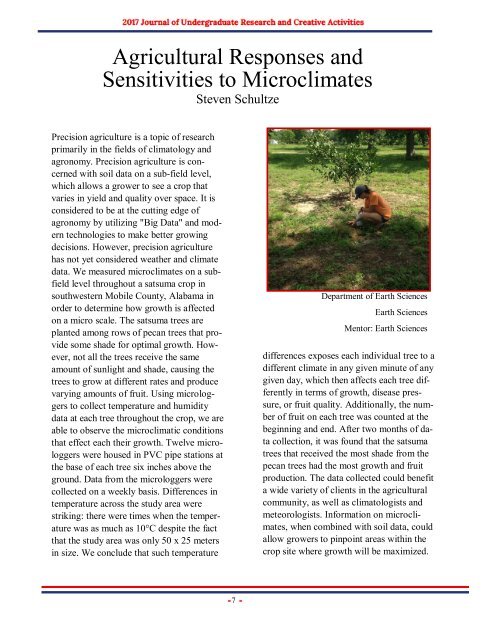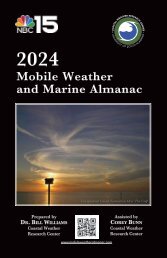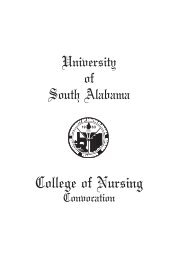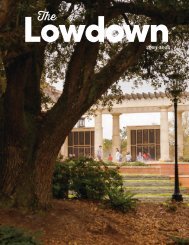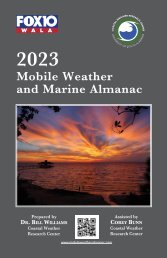JOURACA_SP_2017
Create successful ePaper yourself
Turn your PDF publications into a flip-book with our unique Google optimized e-Paper software.
Agricultural Responses and<br />
Sensitivities to Microclimates<br />
Steven Schultze<br />
Precision agriculture is a topic of research<br />
primarily in the fields of climatology and<br />
agronomy. Precision agriculture is concerned<br />
with soil data on a sub-field level,<br />
which allows a grower to see a crop that<br />
varies in yield and quality over space. It is<br />
considered to be at the cutting edge of<br />
agronomy by utilizing "Big Data" and modern<br />
technologies to make better growing<br />
decisions. However, precision agriculture<br />
has not yet considered weather and climate<br />
data. We measured microclimates on a subfield<br />
level throughout a satsuma crop in<br />
southwestern Mobile County, Alabama in<br />
order to determine how growth is affected<br />
on a micro scale. The satsuma trees are<br />
planted among rows of pecan trees that provide<br />
some shade for optimal growth. However,<br />
not all the trees receive the same<br />
amount of sunlight and shade, causing the<br />
trees to grow at different rates and produce<br />
varying amounts of fruit. Using microloggers<br />
to collect temperature and humidity<br />
data at each tree throughout the crop, we are<br />
able to observe the microclimatic conditions<br />
that effect each their growth. Twelve microloggers<br />
were housed in PVC pipe stations at<br />
the base of each tree six inches above the<br />
ground. Data from the microloggers were<br />
collected on a weekly basis. Differences in<br />
temperature across the study area were<br />
striking: there were times when the temperature<br />
was as much as 10°C despite the fact<br />
that the study area was only 50 x 25 meters<br />
in size. We conclude that such temperature<br />
Department of Earth Sciences<br />
Earth Sciences<br />
Mentor: Earth Sciences<br />
differences exposes each individual tree to a<br />
different climate in any given minute of any<br />
given day, which then affects each tree differently<br />
in terms of growth, disease pressure,<br />
or fruit quality. Additionally, the number<br />
of fruit on each tree was counted at the<br />
beginning and end. After two months of data<br />
collection, it was found that the satsuma<br />
trees that received the most shade from the<br />
pecan trees had the most growth and fruit<br />
production. The data collected could benefit<br />
a wide variety of clients in the agricultural<br />
community, as well as climatologists and<br />
meteorologists. Information on microclimates,<br />
when combined with soil data, could<br />
allow growers to pinpoint areas within the<br />
crop site where growth will be maximized.<br />
7


